If water is seeping through your foundation slab, don’t panic! There are several ways you can stop water seepage, including installing a drain tile, sump pump, or French drain. We talk about those solutions, how hydrostatic pressure plays a part in water seepage, and more in this article.
Why Is Water Seeping Through My Foundation Slab?
The main reason water is seeping through your foundation slab is due to hydrostatic pressure. Hydrostatic pressure is when water builds up outside your foundation walls or underneath your foundation slab. Water weighs around 60 pounds per cubic foot. So, if the soil around or under your foundation is saturated with water, there could be tens of thousands of pounds of pressure pushing against your walls or slab.
- Through pipes in your walls or floors – When plumbers install pipes in your foundation, they drill holes slightly larger than the pipes themselves. After the pipes are inserted through the holes, they fill the gaps using hydraulic cement. When that cement breaks down, which it will, outside water can fill the voids and seep into your foundation.
- Through cove joints – Cove joints are the space between your foundation wall and foundation slab. Without a drain tile system to collect gathering water, moisture can use these openings to enter your foundation.
- Through foundation cracks – No matter the size, water can use foundation cracks to enter your basement or crawl space.
- Through degrading concrete – If sections of your foundation slab or walls begin to deteriorate, water can use the openings to enter your foundation. This is also called honeycombing.
- Over-the-top seepage – Water can enter your basement through the space between your foundation wall and the first floor.
- Windows and window wells – If your basement egress windows or window wells are not sealed and drained properly, water could seep through any cracks or openings and enter your foundation.
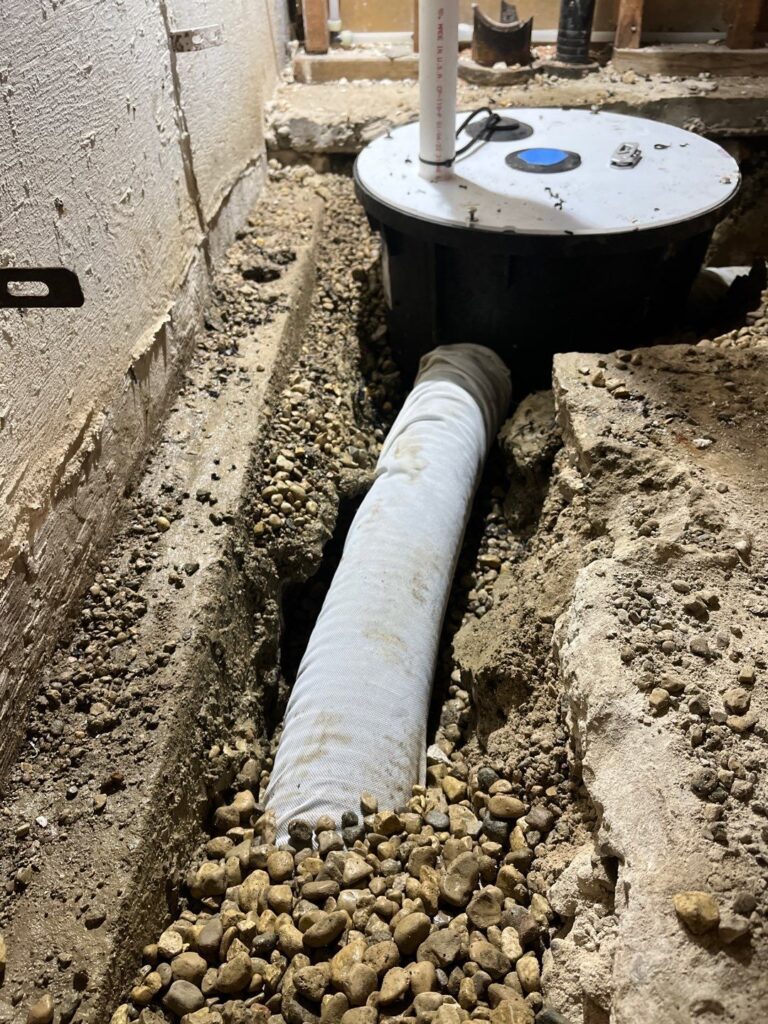
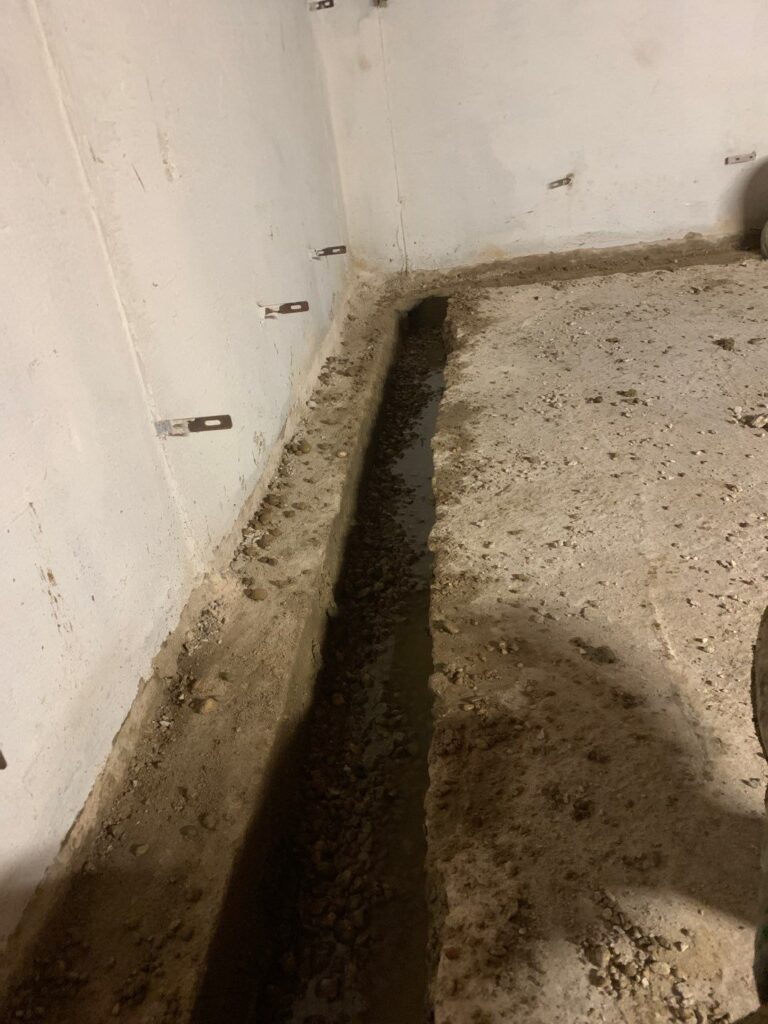
How Do I Prevent Water From Seeping Through My Foundation Slab?
- A French drain will collect water in your yard – If water is pooling up in a low part of your yard or near your foundation, the soil will become saturated with moisture and lead to hydrostatic pressure.
- Gutter extensions will prevent water from pouring too close to your foundation – Your gutters should be dropping water away from your home by at least 20 feet. Otherwise, water can saturate the soil next to your foundation. We also recommend cleaning out your gutters as often as possible to prevent clogs and buildup, which will allow water to pour over the sides.
- Grading your property will counter poor drainage – If your property is sloped toward your home, water will drain into the soil near your foundation, promoting hydrostatic pressure.
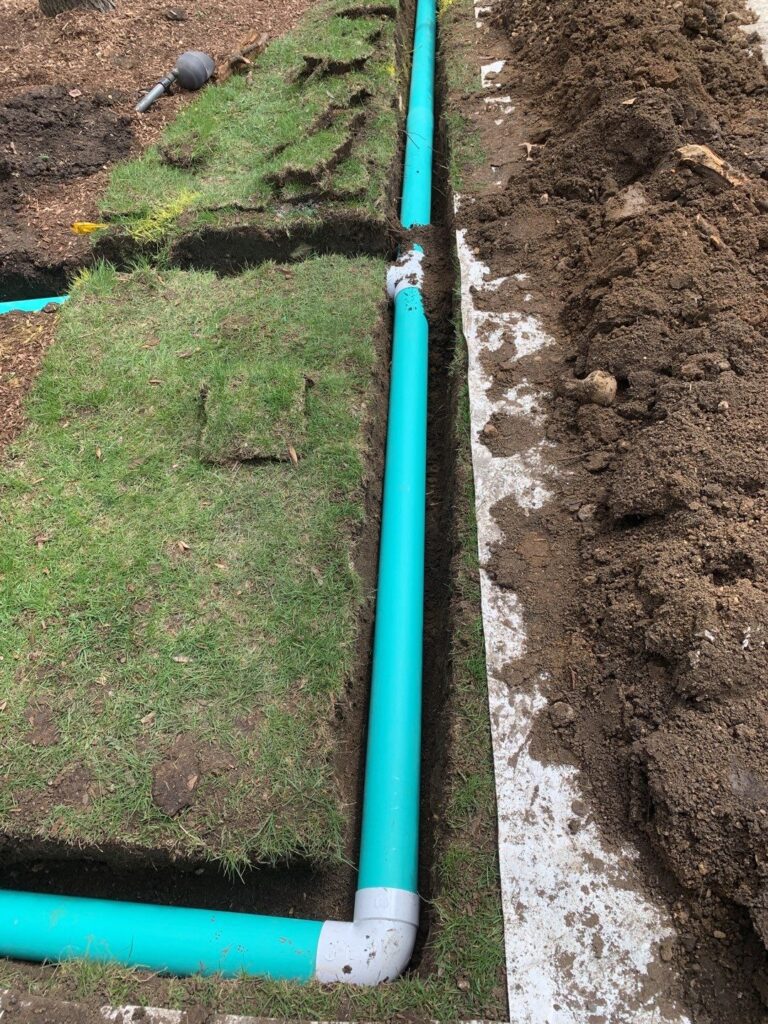
How Do I Stop Water From Seeping Through My Foundation Slab?
- Installing a vapor barrier will counter moisture seepage – A vapor barrier is a thin (10 to 20-mil thick) sheet of polyethylene that’s placed along your foundation walls. This will keep water from seeping through your walls, channeling any collected moisture into a drain tile system below.
- Installing a drain tile system will counter seeping groundwater – A drain tile system consists of a perforated pipe that’s laid in a bed of washed stone at the base of your foundation walls. This system can be placed either under your slab or outside your foundation walls. Any rising or outside groundwater will seep into the perforated pipe and travel to a sump pump.
- Installing a sump pump will eject any water – A sump pump is a fixture that sits in a sump pit. Any collected water in your drain tile system will be deposited into the sump pit, and once it reaches a certain level, the pump will activate and eject the water out of your home using discharge lines. The discharge line will transport water far enough from your home, preventing it from gathering near your foundation again.
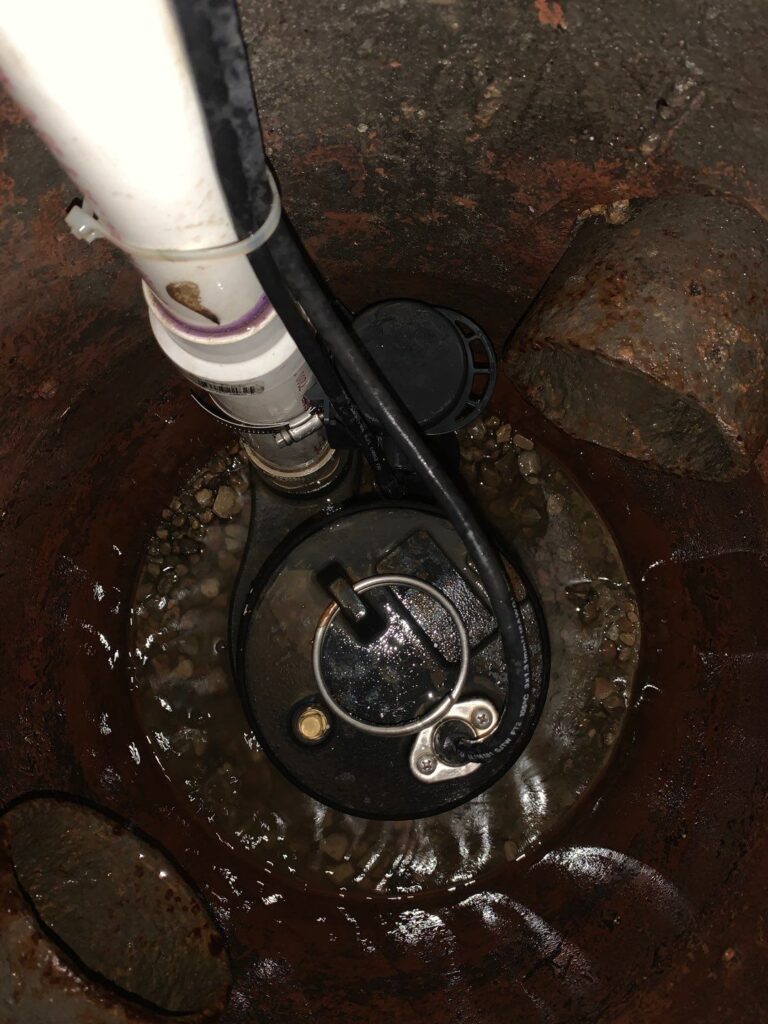
Who Can Help In The Greater Chicago Area?
If you live in the Greater Chicago area and have water seeping through your foundation slab, call The Real Seal Basement Waterproofing and Foundation Repair. We’ll come out and inspect your foundation, pinpointing where water is coming from and come up with the best solution. By combining a drain tile system with a vapor barrier and sump pump, we can effectively waterproof and seal your foundation. Call today for your free inspection and estimate. We also offer foundation repair, crawl space repair, and more!
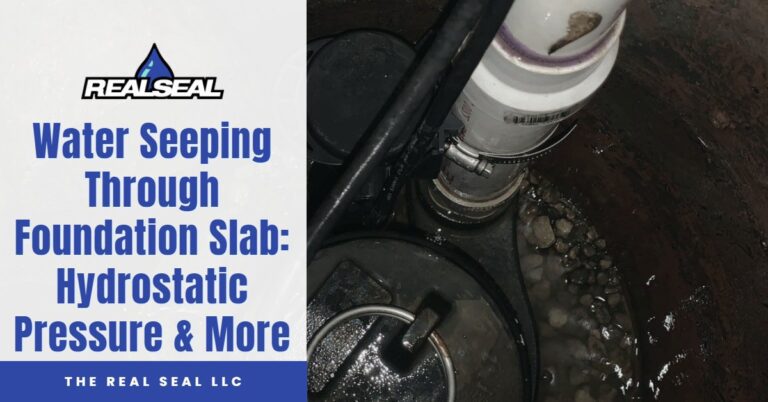
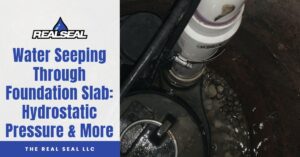
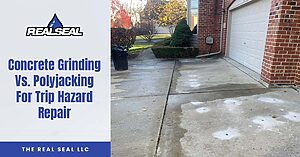
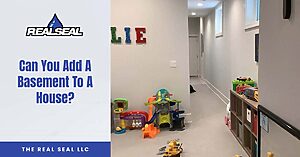
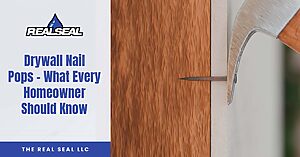
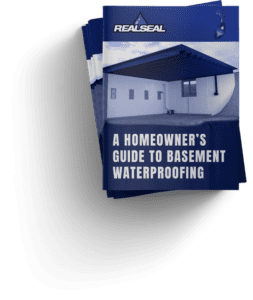

46 Responses
Good day
I have a concrete roof top I need to pour a water base sealant liquid .to follow the seepage track and form a seal
Do You perhaps have any suggestions
nb..It seems to acure it the summer heat when expansion take take place Regards
Hi Ernest!
We don’t do roofing, though an elastomeric waterproofing roofing tar is likely your best bet. I would point you to consult with a roofer to see what they can do.
Hi, I have the same problem as Ernest did he get your situation rectified. How can you assist
Hi Bobbie,
Ernest never replied that he got it taken care of. But what you are looking for is a roofing solution for a concrete flat roof. An elastomeric tar, liners, and insulation tend to be the typical fix. You can also spray expanding foam as an all-in-one solution with the correct contractor as well. It would be best to get a few contractors out there for quotes to get it sealed.
I have a problem in the basement car park where in times of heavy rain, water seeps in to the basement carpark. We have an efficient underground pit with 2 good pumps operating. What is the remedy
Hi Krishn! It’s hard to determine a source of water without a site visit. It is possible you are dealing with Foundation Cracks, Ceiling Cracks, and it is even possible your underground pit is not as efficient as you may think. All these things can be diagnosed with a site visit.
Hi I have foundation slab that is damp from water getting in. The wall is directly under the line separating our driveway and garage floor. The wall is wet but hasn’t gone through the vapour barrier yet. Is this ok?
Hi Robert!
If you are sitting on a slab with no basement or crawl space that is getting water, the best solution will be to manage the water around the foundation from the outside. Gutter extensions, French Drains, and proper grading of the yard so all water flows away from the foundation is crucial. Did you know that the average roof produces 1,000 gallons of water from a single inch of rain?
Concrete, brick, and masonry has what is called the “wick effect.” This is where concrete that sits in water can actually pull water up and even deposit it a few feet up in the most extreme situations. If this is happening, the water that is sitting around the foundation must be moved in order to fix it. I hope this helps!
I live/ own a small condo on ground level, about 30 feet from a big Lake. The lake has nothing to do with this situation, but when we get more than one solid day of continuous rain, water comes in my living room at the foundation, (near the baseboards) and spreads all over my tiles unless I stay right there day and night mopping it up and putting towels there; having to wring them out every 5 min. As a senior in my 80s, this is getting a little old and tough for me to handle. Two years ago when this happened they (Board/Mgt) hired a company that dug a trench about one foot down outside my unit and filled it with concrete. I think they tried to put a waterproof substance there before the concrete. IT DID NOT WORK. It is happening again. Please advise with any resolution that might work.
Hi Marry Ann,
I’m sorry you’re dealing with this. Water situations are always difficult.
To start, the lake does have an effect on your seepage situation. With the lake there, the water table is high and heavy rain will raise it enough to seep underneath your floor. As you are on a ground floor slab dealing with this, water management of the rain and an exterior French Drain would be your best route to stopping the water seepage.
How this would work is by digging a trench around the house, but instead of filling it with concrete, you would place a perforated pipe in a bed of gravel in the trench. This would be graded towards the lake and discharge into the lake as well. All of your gutter downspouts should also be put into the pipes, and those pipes should turn from perforated to solid once away from the home.
In a 1″ rain, the average American Home produces about 900 gallons of water. This is a lot of water to deal with, and if not properly managed, will come into the home. Coupled with a high water table (with the lake so close), water management is essential in your situation to stop the seepage.
I hope this helps!
We recently had 8” of rain in my area. My carport was enclosed approximately 1980 and converted to a den. After water seeped in a few years later along the front of the house the length of the room, we had someone come, dig down to slab and coat the area with tar. Since that time, water has seeped in 2 times—-just a little bit in the 1990’s which was handled with pulling carpet back, drying all, sanitized and shampooed carpet and put back down. The only other time was the rain of 6 weeks ago. Would a reasonable solution be to dig out and tar the area again or use a rubberized foundation compound, or a different method. Thanks
Hi Martha!
Many times, it is not enough to just seal your foundation. We highly recommend installing French Drain or Drain Tile around the foundation in that trench as well, directing the water away from the structure.
Also, you should be looking above the foundation at the siding. Brick and vinyl siding can leak in heavy rain if not properly sealed/tuckpointed regularly. Also window and door flashings, roof issues, and chimney issues can all contribute to seepage of a garage-den conversion. Be sure to get a mason/tuckpointer and roofer out to take a look at all of those areas.
I have a floor drain in my basement that is tied into my French drain that is at the base of my foundation. The system drains into a culvert surrounding my house. When we get a heavy rain, the water level in the culvert is higher than my outlet pipe and water comes up the floor drain and enters the basement.
When the level in the culvert goes down, then the water drains out and seeps down the concrete floor. All dries up in about a week.
Will putting in an expansion plug in the floor drain, to prevent water from entering, cause a problem with hydro static pressure building up andt damage the French Drain or my floor?
I also have a sump pump that runs, but the water drains into the same culvert that is causing the problem.
Hi Kathleen!
While gravity drain systems that discharge straight into an exterior culvert are appealing because you don’t need a sump pump, this is a common issue with them. While you are not so much likely to have problems in the future with damage to the floor, you will be unable to ever finish the basement as it will always have the potential to flood.
During resale, the buyers will request (and likely get) a large credit to re-do the system up to code with the proper sump pump system installed. Something to keep in mind, as future buyers will be expecting to be able to use that space, even if you are not.
I have a basement with a sump pump. The only problem I have had in the 20 years I have lived there (new when I moved in) is when the sump pump faed some years ago. Until this last month.
We had a long period of heavy rain, coupled with a power failure that lasted 6 days so the basement flooded. When we got power ba k the pump emptied the basement nicely, but burned out the pump with constant running, so basement flooded again. I replaced the pump but when it dried out, it left two fairly large areas of pooled water at opposite sides of the long side of the basement, at the same end as the sump pump. Seem to be in the area of where the floor meets the wall but they eventually dried out.
There are no cracks. We have just had another big storm and although the pump seems to be working those two areas now have pooling water again, which doesn’t floe to the sump pit. What can I do? I’ve spent so much money on this already and can’t afford more.
Hello Aileen,
I’m sorry to hear you’re having this issue. When you replaced the pump, did you do it yourself? The entire system completely hinges on the sump pump, and if it isn’t adequate, or there isn’t a battery backup system installed, you are going to eventually have trouble regardless. The sump pump needs to be powerful enough to handle the larger storms we get (minimum 1/2 HP for larger basements) as well as have an adequate backup pump (minimum 1/3 hp) in order to keep up with heavy rainfall.
The pumps sold at big box stores are simply not enough, especially the backup systems. Also, if the basement is original and the drain tile is original, it is possible you have a clay drain tile system. They used to install these before the code changed to make it plastic pipe. These clay pipes deteriorate over time, and when they do, they will need to be replaced. Unfortunately, if this is the case, it will cost some money to install. Many contractors, however, do have financing options to help with the larger cost for those projects.
But before all that, be sure all of your gutters are buried and extended at least 15-20 feet away from the home. You may just be overloading your system with gutter water, which is common. Hope this helps!
Sorry for the typos.
Not a problem!
Am having a problem with a swimming pool that have hydrostatic flow, it’s new pool that has just be pour with concrete during this rainy season in my area, water started coming out from the concrete ground what can I do to solve this problem am really worry about this challenge
Hi Felix!
Every problem has a solution. In order to find the solution in this case, you will need to investigate to get more info, and most likely you’ll need to drain the pool to discover the source of the leak.
Most likely, you have a crack in the concrete wall/floor of the pool. Otherwise, you could also have a pipe feeding/filtering the pool that is leaking.
If the pool is cracked, you can do an epoxy injection with carbon fiber reinforcement to seal the crack. For anything else pool related, you’ll have to consult who built the pool. First step would be to call the pool company that installed the pool.
At the rear of my house is the kitchen it has a wooden floor then a 2 foot drop then a concrete slab same of the rest of the house except under the stairs at the front of the house it’s just clay which is really wet. Now water comes in from somewhere under the slab in the kitchen makes its way to the front of the house wear the stairs are 20 feet to the front door’. I put a sump pump under the stairs which helps a bit but still wet and a bad odour going up stairs also in the front bedroom smell really bad think it travels up the cavity. I don’t know if the hole house has waster under it because of the concrete slabs. My neighbours don’t seem to have a problem. Waster boated say it’s surface water. Should I get someone to dig the concert slab out from under the kitchen and lower the slab.
It seems they built your home with a small crawl space beneath. A sump pump alone will not solve this issue. You may have to install Drain Tile along the interior or exterior perimeter to help mitigate the water. On top of that, an encapsulation of the area below the floor may be necessary to keep the moisture and humidity down if it is really bad.
I have converted my garage to a living space and keep having issues of water puddling up in the center of the floor. I am at the base of a large mountain and know the water table is high as I just built a new house and during excavation we hit water only a few feet down. The garage of course has the driveway in front, with a couple large cracks, along with a back patio. Both concrete patios are ground level with the slab of the garage. Would I need to tear up the concrete to add French drains? Or just add French drains where there is soil? How deep down should I dig for the French drains? Also, for the cracks in the driveway, is there any special compound to seal this with? Unfortunately the grade of the driveway is right at the garage with a channel drain catching it. Thank you!
Hi Jared!
For this situation, you will need to break up concrete to add French Drains or Drain Tile. If done on the inside perimeter of the foundation, you only need to go down 12″ or so so you are next to the footing. On the outside, your footing may be deeper, and you will need to get down to that footing in order to install this correctly there. We have a How We Do It Video on our media page that shows exactly how Drain Tile is installed.
For the driveway, you can use a hydraulic cement and silicone top coat sealer. You may want to explore Polyjacking to lift and level that slab if it’s sinking into the ground.
Bought a house with a sunroom that was converted into a Sheet rocked 3 season room. They put a wood foundation on the slab. It leaked and mold formed on sheet rock. Sheet rock 4’ around was removed and replaced also had the slab cut closer to foundation because the water leaking in. I pitched the ground away from house had a drain put in outside to move water away. During the last big storm water leaked in again. The question is can i seal/ waterproof the seam between the slab and foundation on the inside and what should i use
Hi Leonard,
I wouldn’t suggest sealing the slab from the inside if the foundation is made of wood. When it comes to slabs, the best solution is water management. You may need perimeter French Drains on the exterior to move the water away. Also look at your gutter downspouts to ensure that they are at least 20 feet from the addition. The problem with conversions like that would be the little details that can cause leaks. Bad seals/seams/flashing/roof/construction can all contribute to water leaking in. Any sealing should be done on the exterior in your case as well. If water already made its way through the seams and seals, an interior patch will not hold it back.
We bought a house that had an addition built. The addition is a two car garage with bonus room on top. The garage addition butts up to the basement in a lower area of the house. When it rains, water comes in the seam where the addition was added. Water fills the garage floor and comes in a small area of the basement. The area where the seam is, there is a retaining wall there as well. There is no where for the water to go u less we route it through the retaining wall to the driveway. What can we do?
Hi Jessica!
One solution is you can prevent water from getting into your garage in the first place. The best way to accomplish this is through a grate drain system in front of the garage. The link below is an example of one we have installed.
https://youtu.be/McLPCvI8vQk?si=2fk8KIpNgySwstSg
On top of that, I would suggest you use a waterproof sealant against the floor/wall of the garage to the basement. It will help to keep water from entering that seam. Both together is the ideal solution.
It would also make sense to evaluate any gutters in the area. Are they buried and extended at least 20 feet from the house? If not, you’re managing a lot more water around the garage that could also lead to structural issues down the road.
Hi!
We added a new back concrete patio a few years ago. Ever since then where the back door meets the stair case, under our staircase water pours down when it rains a lot. We have had someone out and they filled the area but they believe it is from the concrete patio not being dug far enough down and the wall area being shorter. What would be a way to fix this so we no longer have water coming in? Is there a way to fix it without tearing up the concrete patio and redoing it?
Thank you!
Hi Bre!
There is a possibility to get that fixed without removing the concrete, and I’ll outline that below, but it’s not 100%.
What is likely happening with the slab being poured too high is that that slab is covering the seam between the top of the foundation and the bottom of your 1st floor. That seam is where the water is pouring in. Now, the water can get to that seam from above and below the concrete.
Above by rain hitting the slab, building up against the house, and using gravity to go down into that seam. You may attempt to stop this by using a construction sealant (not caulking from a box store) and painting that seal to protect it from UV light.
From below, the water is gathering under the slab, building up, and with hydrostatic pressure, pushing up and over that seam of the foundation wall. This one is harder to tackle. You can do a French Drain along the entire perimeter of that slab to try to keep the water level and pressure below the threshold for going over the foundation. Problem here for a lot of people is their yard slopes up, so they have nowhere to run the water. You can bring the French Drain through the foundation to a Sump Pit that can then pump it out and away from the home if the yard’s slope is no good.
Both of these together can solve it, but the proper solution is to have the slab poured at the correct height, leaving a few inches of the top of your foundation exposed. That way, the water isn’t building up to come in.
Does that make sense?
My chicago il 2 flat brick building basement have damp moisture on the wall each time it rain and snow. My next door neighbor and my building have a small area of grass which the grass is at my building and his cement walkway to his building. That side of my building interior in the basement have the moisture. I had the interior grined and sealed 2 years ago, now i have moisture again on that same wall. What’s the easiest and best way to stop the damp moisture
Hi Yvonne!
Grinding and sealing the inside of a wall is not the proper way to waterproof a foundation, unfortunately. It will ultimately always leak.
You can either dig and seal your foundation from the exterior, or install an interior Drain Tile with wall covering to re-direct that water away.
If you’re looking to stop any water penetration through the foundation at all, seal it from the outside.
We have a walk out basement. When it rains, rain water may be getting under the slab, running under the house. It hits the foundation wall and comes into the basement in one room but follows the lay of the room, goes under an interior wall and soaks the carpet in the living area. We can see where it comes in as we have drywall off the wall. We can also feel it in the weep channel, or whatever you call it. We are not talking about a little water. We have two large shop vacs sucking up water and have removed well over 80 gallons at a time. We have 4 inch gutters, downspouts buried away from the house. We have added more downspouts Had the area graded to slope, installed a french drain right in front of the area. Our home is all brick veneer, two story with a walk out basement. It is less than 20 years old
Hi Yolanda,
It seems you have a typical Hydrostatic Pressure issue. The water around your foundation is building up and forcing its way through the floor. The best way to get rid of this is with an Interior Drain Tile System. It is likely the system that was installed at construction was not adequate or it was installed incorrectly. Even with a walk-out basement, you should have a full perimeter Drain Tile System. This will prevent that water buildup from under the floor, and stop that water issue.
I have a northern built home in florida and have a basement with water seepage. Do you know anyone in fort myers that can do what you do?
Hi Diane!
Unfortunately, we do not have anyone we know in Fort Myers area. We would suggest going on review sites to find the best company in your area.
There is an apartment that has water coming up at the edge of thier carport almost to where the street line is. It started a few nights ago out w/ a couple tiny holes along a crack and is now a little smaller then size of a dime w/constant water bubbling and flowing out of it. Now there was some construction being down to a house halfway up the alley, they removed a humongous tree and repaved their driveway amongst other things. Is this what caused this? And I live across the street from them, I’m just wondering what possible damages can occur from this. Like is there a possibility my car-or house- could collapse into a sinkhole from it???
Hi Trista,
It would be best to call the village for them to come out and inspect. It may be caused from construction, a broken water line, shifting water tables, heavy rain, etc. It’s very difficult to diagnose over the internet. The village inspector or engineer will be able to come out and take a look and help you out. Give them a call.
I just wanted to add that it’s been scorching hot temps here for a long time. I don’t think we’ve ever had any rain since perhaps March or early April.
Also when I asked if it could be the house doing all the construction a few weeks and I said it was halfway down the alley–its a few houses down, im guessing maybe about 125′-150′ away? If that helps.
Same answer as below. You need to call the village/township/city to have them come check it out.
Hey Austin, I live in a ranch style built on a slab in an area known to have a higher water table (pool & nearby river) . Having some water push through the grout in the floor of my house. Slowly and obnoxiously. Even a week with no rain, the grout spots are “weeping.” My reading seems to point me to hydrostatic pressure under the foundation.
In heavy rain, there’s pooling in the back yard and along the side of the house. A front gutter was recently unclogged, but floor issue seems to persist.
Do you think a French drain will solve all this or is there something more advanced to relieve water under the foundation/lower water table and keep it from pushing through the floor grout?
Thank you!
Hi Alex!
It does sound like you are dealing with a Hydrostatic Pressure issue. While a French Drain on the surface outside can help relieve some of the pooling, it likely will not rid you of the issue altogether. The only way to assure that you won’t get that water will be to install a Drain Tile system against the perimeter of the home. Once that is installed, the system will keep the water level below the floor, preventing that seepage through the grout. Let me know if you have any other questions!
Hello! We have a ranch style house built on a slab in a high water table area. We have groundwater seeping thru floor. Yrs ago we originally had carpet in 1st floor bedroom an unrelated flood caused us to pull up and re-do flooring. Carpet sporadically had wet spots. When removed carpet, underside was covered in mold. Red guard waterproofing was painted on slab & new floating (no pun) vinyl flooring installed. Tile or carpet was only other option. 3 yrs later AGAIN had an unrelated pipe issue causing a flood UGH! Once again flooring required changing. When removing the vinyl flooring we again found mold. Contractor says to remove Red Guard (grind off slab), use a “bubble like” vapor barrier, a thin cushioned vapor barrier, and we can install a “floating” engineered wood floor or vinyl. We are concerned this method will once again produce mold as before. What is best way to prevent seepage from slab into flooring, whichever type we choose. Tile is not ideal and a bad future selling point due to our home location. Thoughts? Any guidance appreciated
Hi Tara!
That does not sound like a fun situation, so sorry you are dealing with it! When it comes to slab homes (no crawl space or basement underneath, just the concrete slab), it is difficult to manage the water. In basements or crawl spaces, we install Drain Tile Systems around the perimeter of the area to capture the water, move it to a sump pit, and pump it away from the home.
We have only done a small amount of these projects on slabs, for obvious reasons that I will still list. You will need to break up an 18″ trench around the entire home inside, and run that Drain Tile to a pit, likely in your mechanical room. The demolition and rebuild of the interior perimeter of your entire home is an undertaking.
Another option is an exterior Drain Tile. This will involve needing about 6′ around the entire home exposed. So driveway, patio, porch, etc would have to come up in order to install the system. The problem with this one, however, is you cannot run the pipe inside to a Sump Pit like traditionally in a basement, depending on how deep your frost wall is. Even if you’re just on a slab, most areas in the United States have required Frost Walls, which is a foundation wall that goes between 3-6′ beneath the ground to keep the slab/home from heaving/sinking from the freeze/thaw cycles. In this case, a deep pit outside with some special considerations can work, but is more costly and will require more routine maintenance.
Either way you cut it, unfortunately, it would be expensive. To start, I would suggest moving all the Gutter Downspouts to buried ones that are at least 15′ from the home, re-grading the dirt so it slopes away from the home, and possibly installing a surface French Drain to help move the water.
Hi Austin,
We had a large slab leak in our home that was enough to fill part of the first floor with water and buckled all the flooring. Since then, we have had companies come in with dehumidifiers and fans to dry out the floor, but after one year, the moisture keeps returning and is still too high (4.5 – 5.5 on the moisture meter) to replace the floors and put back our walls and cabinets. No one knows how to fix this. I’d really appreciate your assistance!
Hi Nikki!
Sorry you are dealing with this. If you are on a true slab with no crawl space or basement, it is very likely groundwater penetration. Exterior French Drains and Gutter Extensions can go a long way towards keeping the water away from the home. If that doesn’t work, you may need to do an Interior Drain Tile in order to stop the water.